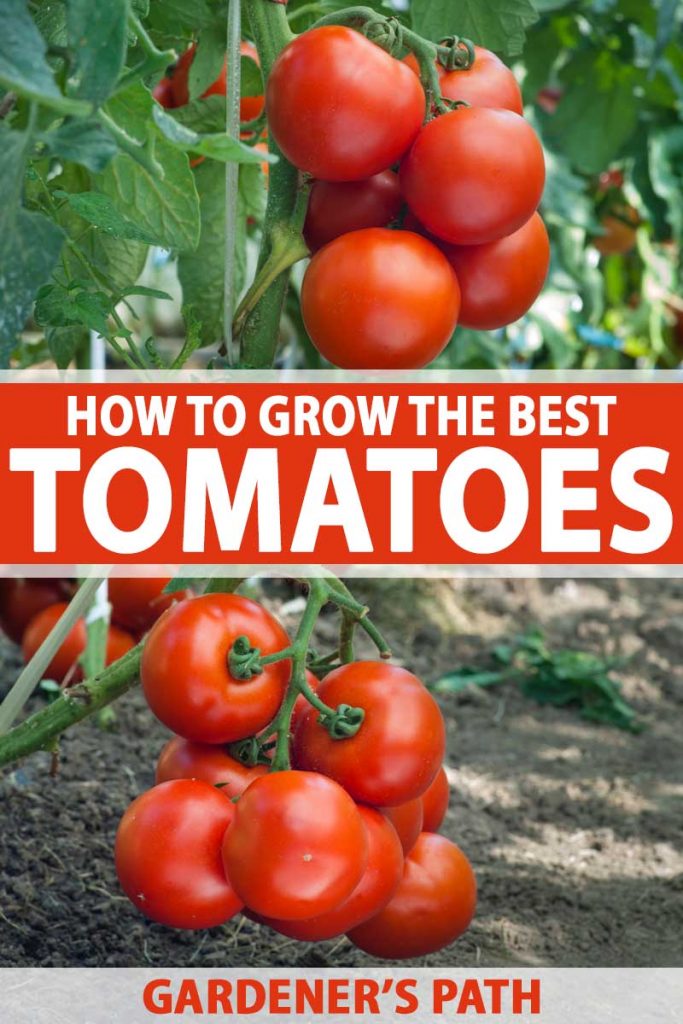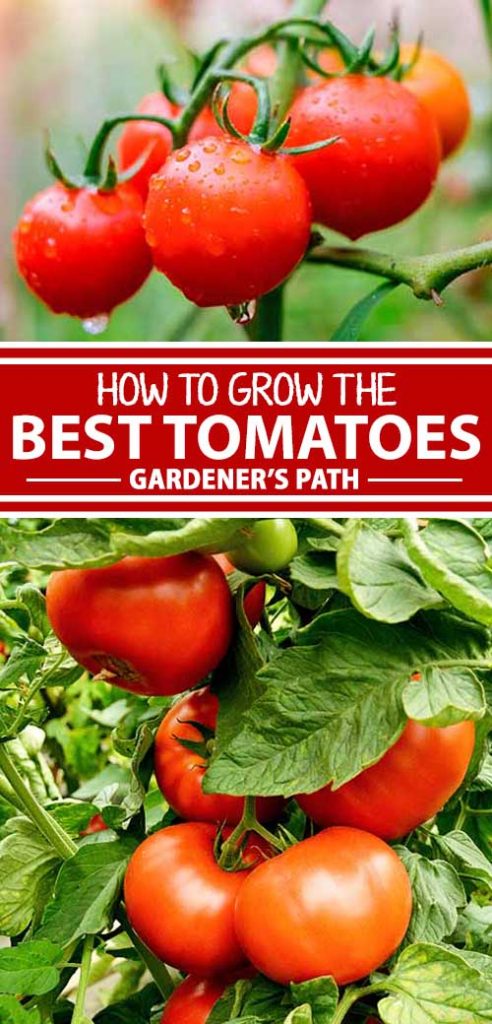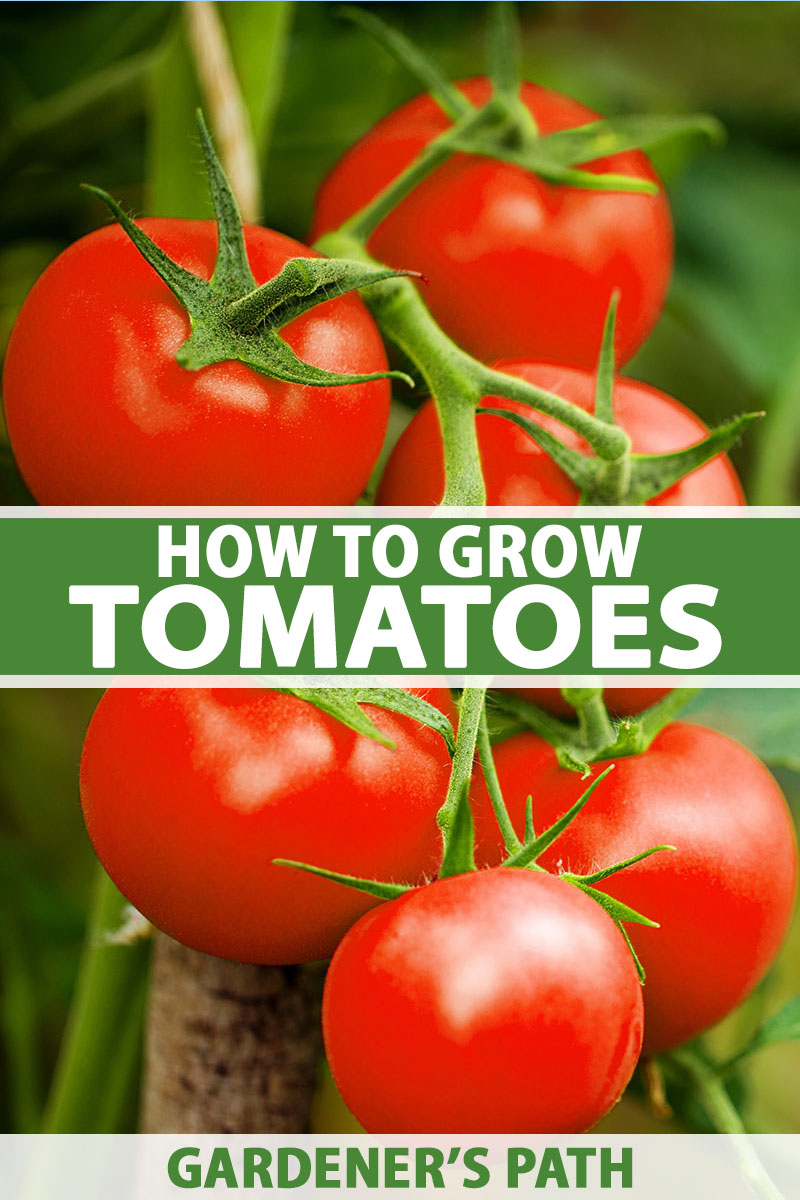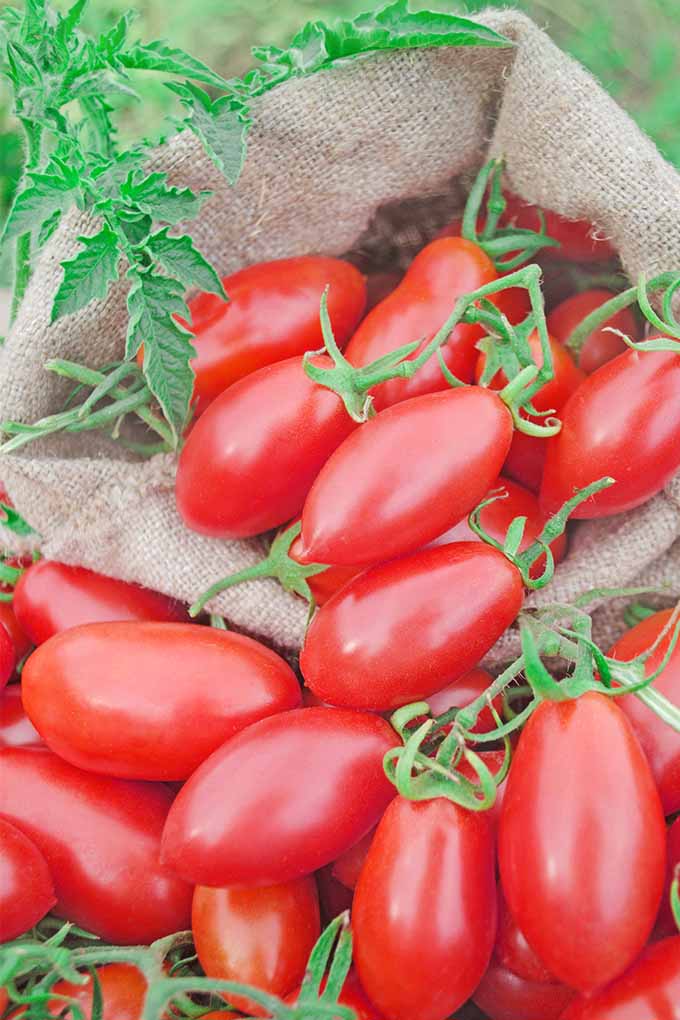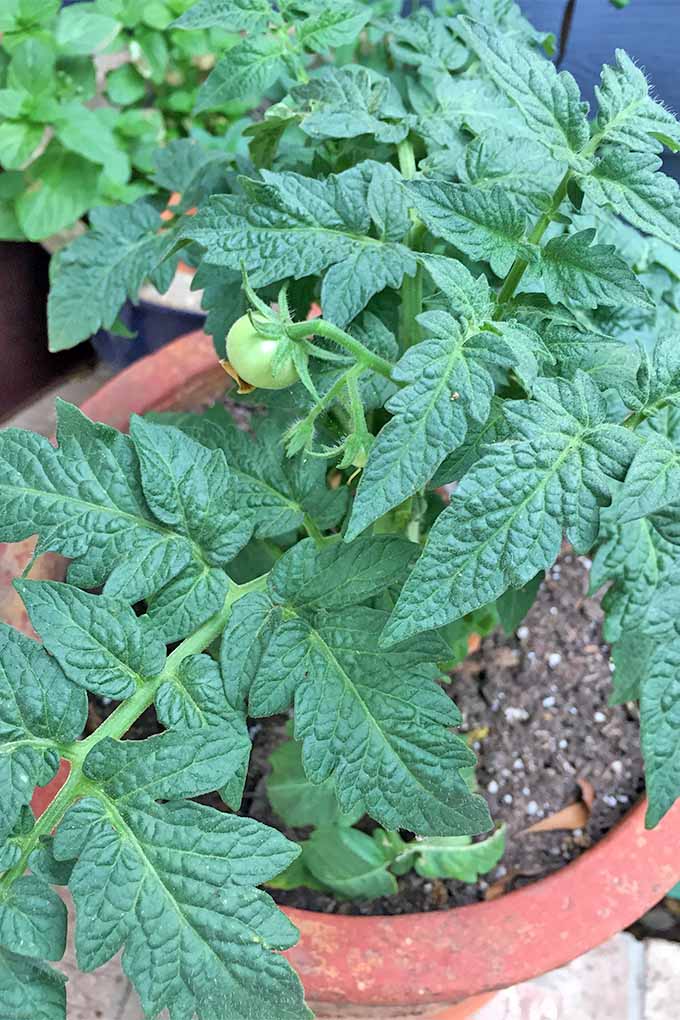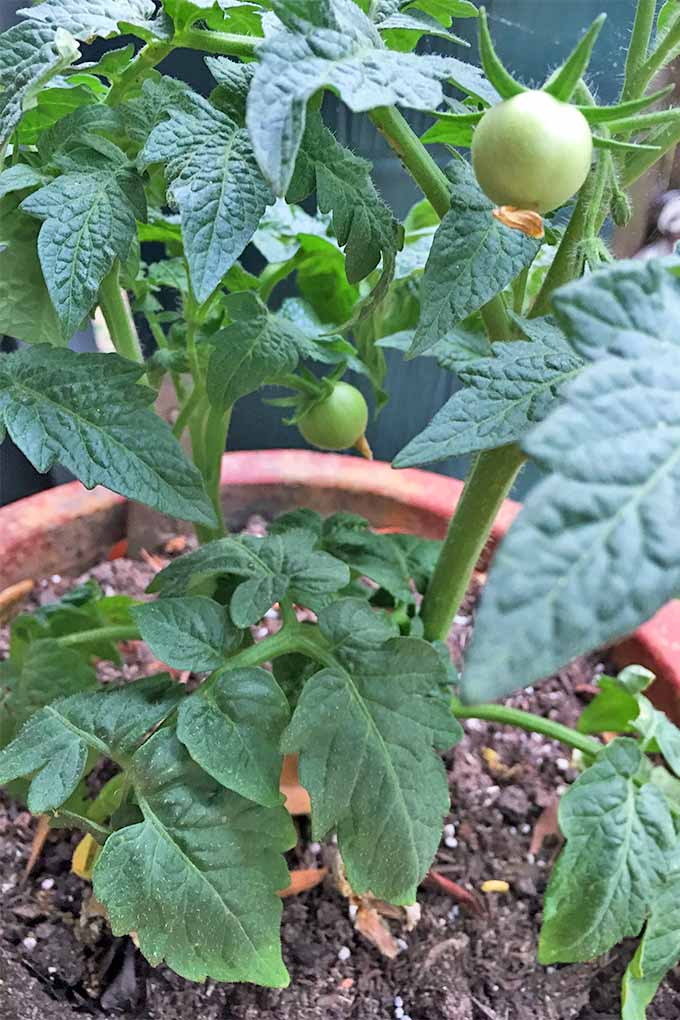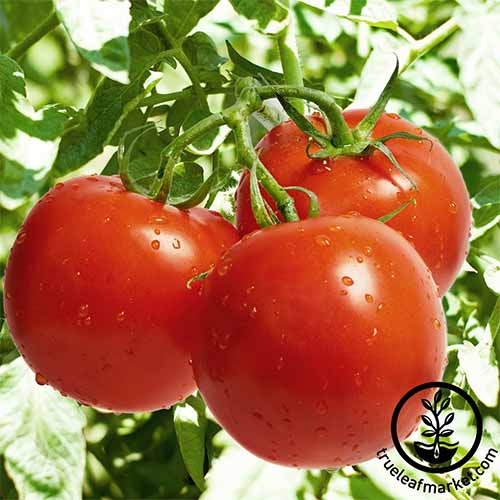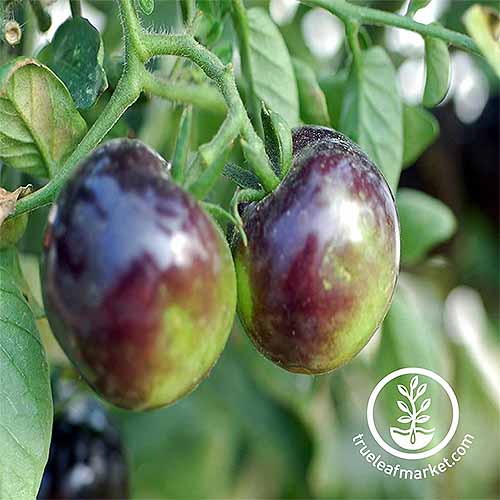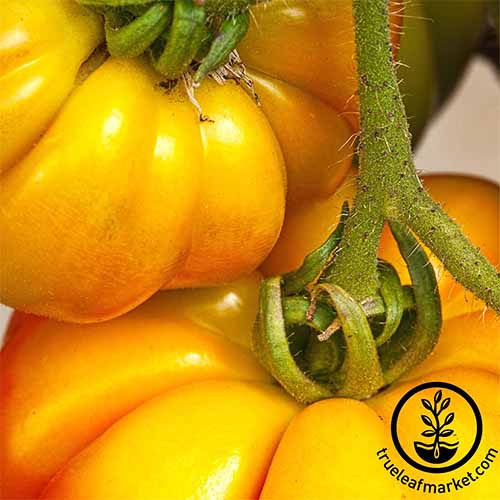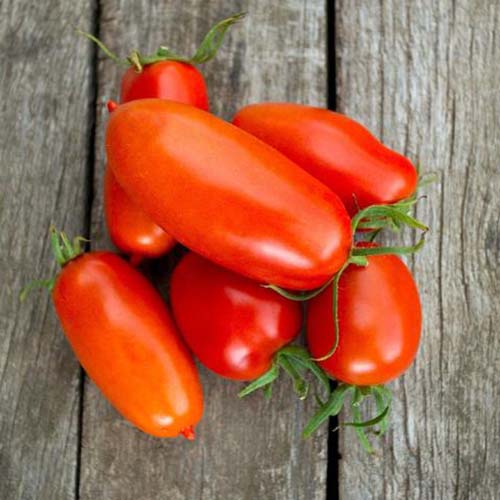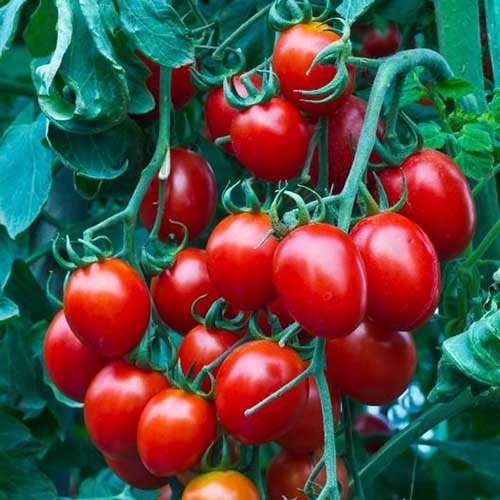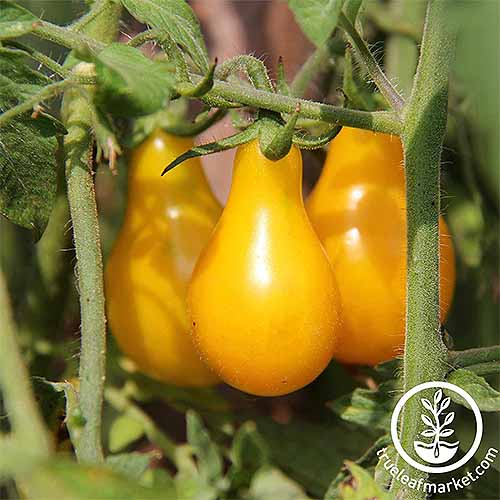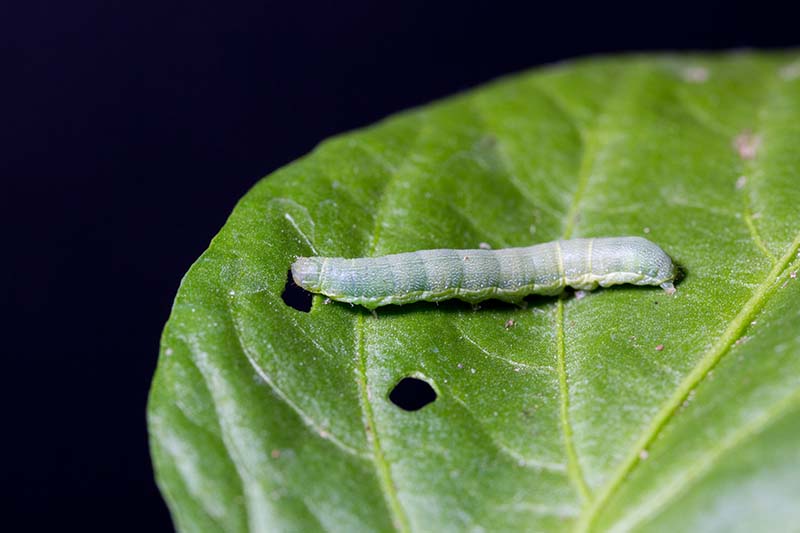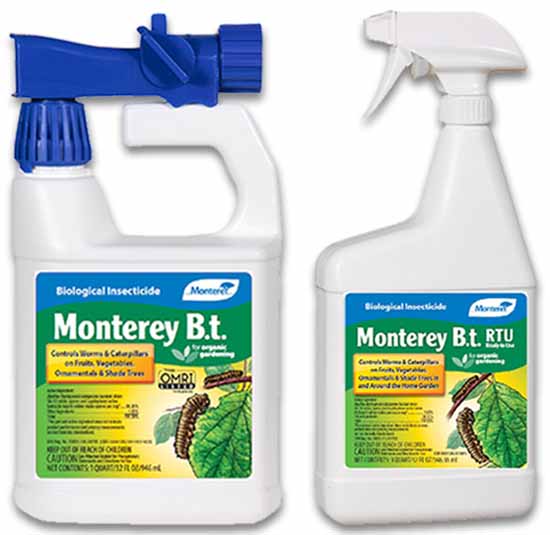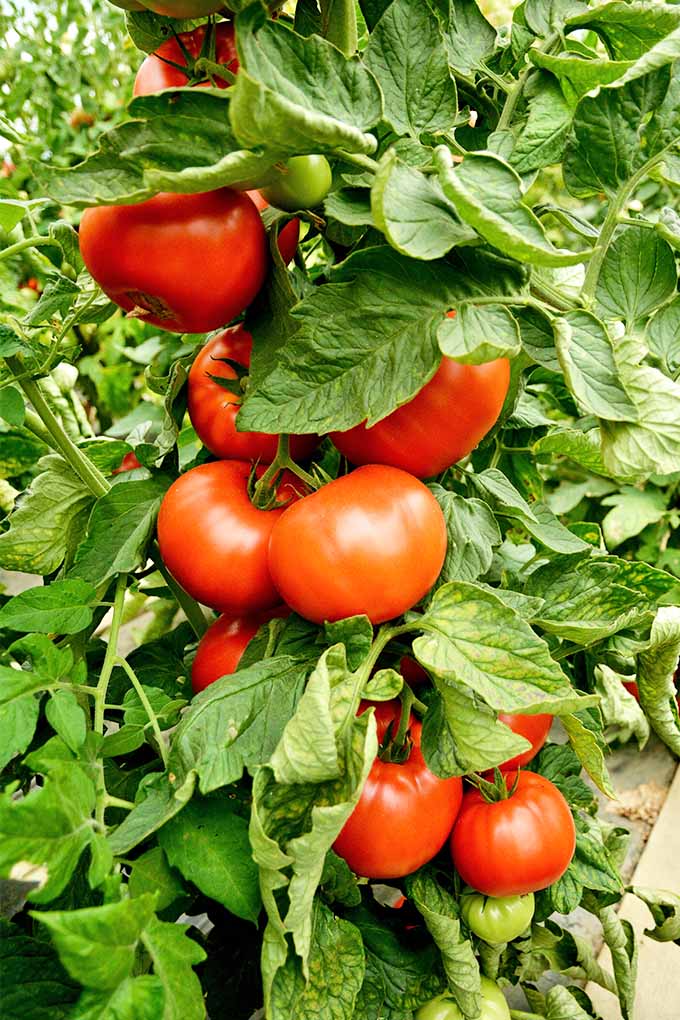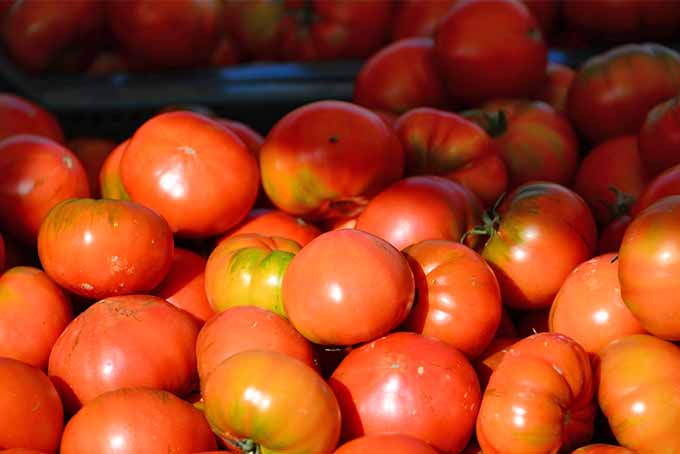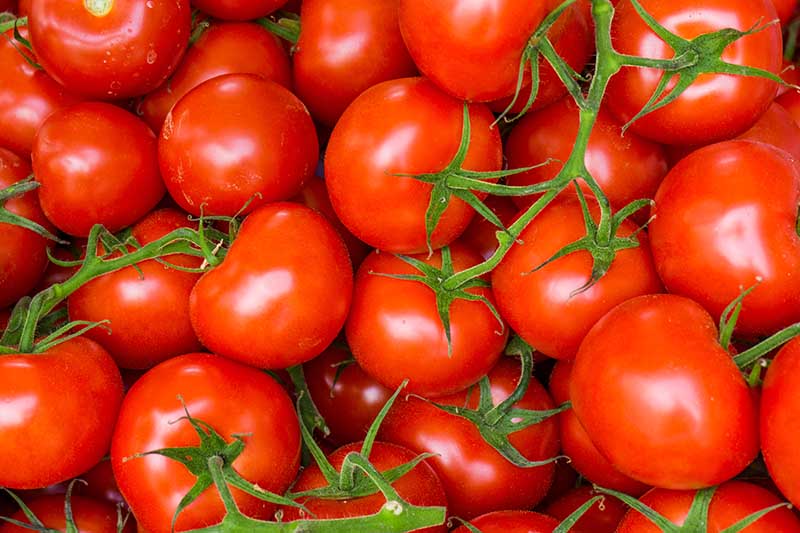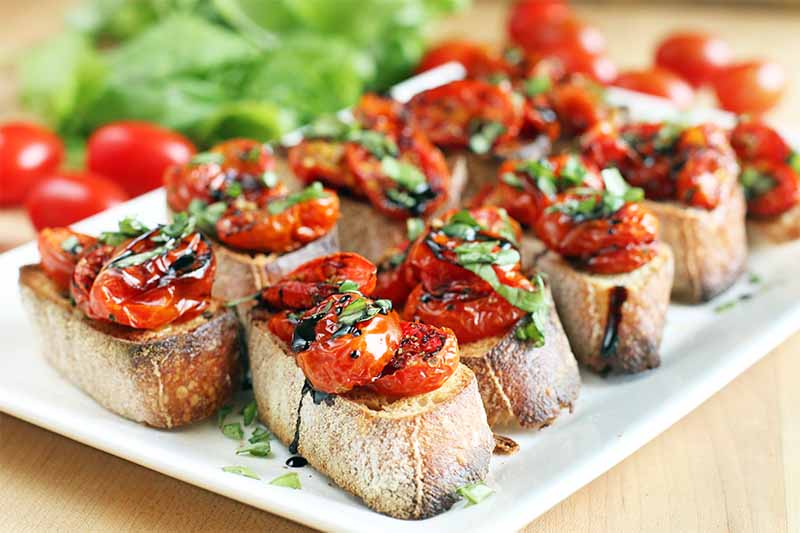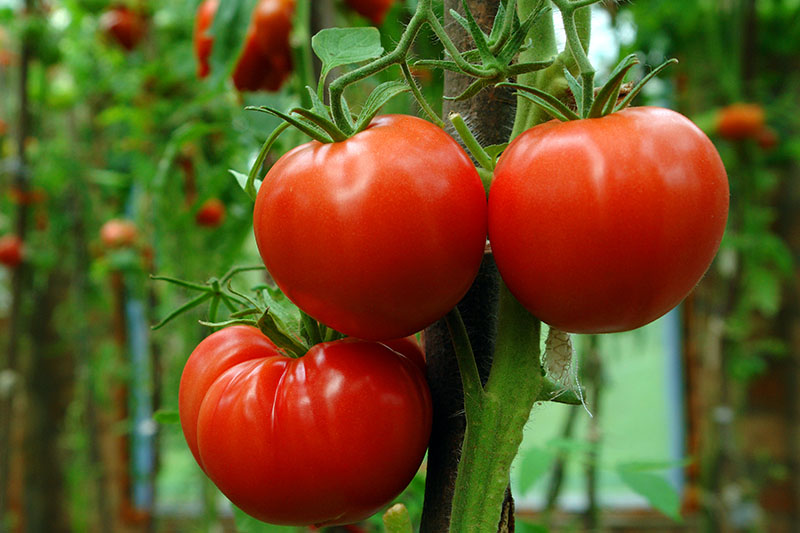Not only is a fresh-picked, homegrown tomato extraordinarily tasty, especially when compared to the supermarket variety, Solanum lycopersicum is easy to grow, and thrives almost anywhere. Just a few plants will provide enough fruit for your entire family. Because they flourish in the summer heat, they are a summertime favorite in gardens across the country. We link to vendors to help you find relevant products. If you buy from one of our links, we may earn a commission. Unbeknownst to many, S. lycopersicum is actually a fruit, not a vegetable. Culinarily, of course, we consider them to be vegetables. But botanically, they are fruit, because they are seed-bearing structures that develop from the ovary of a flowering plant. Now that we have that bit of science out of the way, let’s learn more about choosing and growing the perfect tomato for your family. Here’s what’s to come:
Cultivation and History
Native to Central and South America, tomatoes have been cultivated since the time of the ancient Mayan civilization.
They were later grown in the southern part of Mexico by the Aztecs. After the Spanish invasion of Mexico (1519-1521), tomatoes were introduced to Europe by returning colonists. In Spain, the name tomate is a derived from the Aztec name, tomatl. In the mid-16th century, they became popular in Italy, and were renamed pomo d’oro, the “golden apple.” At the same time, tomatoes were grown in Thomas Jefferson’s Monticello garden, from seeds obtained in Europe. Today, tomatoes are one of the major vegetables in US cuisine.
Determinate vs Indeterminate
Often, the first consideration when selecting a S. lycopersicum plant is whether to choose a determinate or indeterminate variety. Indeterminate types grow all season, and continue to bloom and produce fruit as long as weather conditions are favorable. They also tend to be viney space-hogs that require extensive staking or caging. Determinate types grow in a more compact, bushy form, and produce their fruits all at once. After fruiting, they stop growing and die. This means you’ll have a huge harvest that’s perfect for canning, but you might not be able to enjoy caprese salads all summer long. You can read more about indeterminate and determinate characteristics here.
Propagation
You can start seeds indoors six weeks before your expected last frost date. This tender annual is sensitive to cold weather and frost, so don’t set your seedlings or nursery starts out too early. Wait until all danger of frost has passed, when air temperatures remain above 55°F and soil temperatures are consistently 65°F or higher. This is usually a couple of weeks after your average last frost date. In Austin, I always put my tomatoes out the second week of March, and have never had a problem. This year, however, we’ve had some bizarre April nights where the temperature has dropped into the low 40s. It appears the little green fruits are okay, but some of the leaves are definitely showing cold-weather damage. We delve into the best planting times here. Place seedlings in an area where they will receive six hours or more of sunlight – unless you live in Zones 8-10, where about 5 hours of full sun are sufficient. If you are transplanting from indoor-grown seedlings, don’t put your plants outdoors without getting them used to the different climate first. To harden them off, begin by setting them outside for a few hours each day in the shade. This way, they will become acclimated to the difference in temperature. Increase the time they spend outside every day over the course of about a week. If you put them directly in the sun at the start, they will end up with sunburned leaves. Learn more about how to start tomatoes from seed in this guide.
How to Grow
Try to plant in an area that receives early morning and late afternoon sun, and that is shaded during the hottest parts of the day. If your growing area only receives about 3 to 4 hours of sunlight per day, you can still plant cherry tomatoes. The plant will not grow to be as big as it would in a full sun location, but it will still produce a decent harvest of fruit. Tomatoes grow best in organically rich, well-draining soil, with a slightly acidic to neutral pH of 6.0-7.0. You can even grow them in clay, if that’s what’s available in your garden. You can conduct a soil test to determine the nutrient content and pH of your soil, and amend accordingly. If your soil is particularly poor and you feel nutritive amendments make sense, add them at the beginning of the season, before the plant is in the ground. Don’t use compost or fertilizer after the plant is in the ground. Too much nitrogen will cause it to produce lots of leaves but little or no fruit. Choose a balanced fertilizer or one with a slightly lower ratio of nitrogen, so you don’t end up with lots of green leaves and no fruit. When planting transplants, dig a hole deep enough to bury the stem just past the first set of leaves. Deep planting of seedlings allows them to generate a better root system, resulting in a stronger and more productive plant. These plants need to be spaced about 3 to 4 feet apart if they are not going to be caged. And if they are, you can get away with 2 feet between each, but be careful to maintain adequate airflow. If you’re growing all determinate varieties, they can be squeezed in a little more tightly, with about a foot in between. My rows are usually a jumble of both types, so I give them a little more room – though I might sneak a low-growing pepper plant in between, so no inch of garden goes unused.
Planting in Pots
Container gardening is a good solution for those who live in apartments and condos, without the luxury of a full-sized garden. All you need are containers, potting soil, seedlings, and a few good practices. While it might be fun to try the heirlooms that some garden stores sell, they might not do well in every region. S. lycopersicum thrives in hot weather, but it is possible for the weather to be too hot for the plants to set fruit properly. If nighttime temperatures stay consistently above 75°F, the pollen can be rendered sterile. Humidity can also have an impact on fruiting. Very high humidity can prevent the pollen from dropping, and in low humidity areas, the flowers may become so dry that pollen won’t stick. Frequent watering may help to raise the humidity. But ultimately, your best bet is to look for cultivars that are developed for your growing conditions. In Austin, for example, local nurseries have shelves and shelves of tomatoes available with “heat loving” or something similar in the plant description.
First, make sure your containers are large enough. You don’t have to purchase expensive pots – 5-gallon plastic buckets with drainage holes punched in the bottom will do just fine. In general, plants grown in containers – including tomatoes – require considerably more frequent watering than plants grown in the ground. Additionally, plants grown in containers will be more compact at maturity than those planted directly in the soil. Roots are the primary limiting factor in total production, which is why potted plants never grow as big or produce as many fruits as plants grown in the ground. Read our full guide on growing tomatoes in containers here.
Hydration and Support
Try to be consistent with watering to keep the soil evenly moist, but not wet. Going from dry to soaked soil can cause the fruit to crack. Deep watering is preferable to more frequent, light watering. You want the moisture to go deep enough to reach all the roots. On average, plants require 1-2 inches of water per week. Another significant aspect to caring for S. lycopersicum is the need to cage or stake plants, particularly the vining indeterminate types. Growing tomatoes in wire cages is one popular method among gardeners because of its simplicity. Cage training allows the plant to grow in its natural manner, but keeps the fruit and leaves off the ground. Other gardeners stake their tomatoes. This requires tying the vines to a stake to support the plant and keep it off the ground. The Florida Weave method is a great option for this. Whether you choose to cage or stake your tomatoes, add the apparatus right after transplanting your seedlings. Inserting a stake or cage later risks damaging the plants’ roots. Some gardeners in particularly windy areas – where cages or stakes are apt to topple over – may choose to let the vines sprawl along the ground instead. Evidence is mixed as to whether pruning does anything to increase tomato production. What about suckers? Many gardeners swear by removing these shoots that grow between the main stem and a leaf. They suggest that suckers should be broken off while they are still small, less than four inches long. This enables the plant to put its energy into growing fruit rather than more foliage.
Cultivars to Select
Before deciding which cultivars to choose, consider your intended use of the fruit. Are you looking to preserve your crop for later use in sauces by canning? Or if you’re looking for tomatoes for fresh eating, do you want diminutive cherries or larger slicing types? With so many varieties available, other considerations include heirloom types versus hybrid varieties, color (not all tomatoes are red!), and of course, flavor.
Managing Pests and Disease
As tasty as tomatoes are to humans, they are equally delectable to a number of pests, from insects to mammals, including landlords (more on that later). Several fungal and bacterial diseases can be a problem for these plants as well.
Celebrity
‘Celebrity’ is an All-American Selections-winning hybrid with a delicious, sweet flavor.
‘Celebrity’ Medium to large, deep red fruits are produced on determinate plants. You can find seeds in a variety of packet sizes, available from Mountain Valley Seed Co. via True Leaf Market.
Indigo Rose
Or, surprise the family with purple tomatoes! ‘Indigo Rose’ is a compact, indeterminate cultivar that produces fruits high in antioxidants.
‘Indigo Rose’ Cocktail-sized fruits develop their characteristic purple color when grown in a full sun location. You can find seeds in a variety of packet sizes from True Leaf Market.
Persimmon
For a colorful indeterminate variety, consider ‘Persimmon’ – a Russian slicing tomato that’s yellow instead of red.
‘Persimmon’ Large fruits are ready for harvest 80-90 days from transplant. You can find seeds in a variety of packet sizes available from True Leaf Market.
Roma
‘Roma’ is known as a particularly good paste and canning tomato. This heirloom variety matures in 80 days.
‘Roma’ Determinate plants produce high yields of sweet-flavored fruits. You can find seeds available at Eden Brothers. Read more about growing Roma cultivars here.
Small Red Cherry
If you’d like to try your hand at growing cherries, consider ‘Small Red Cherry.’
‘Small Red Cherry’ This high-yielding, indeterminate heirloom cultivar matures in 70 days, and produces sweet, flavorful fruits. You can find packets of seeds in a variety of sizes available at Eden Brothers.
Yellow Pear
For a pear-shaped dollop of sunshine, consider ‘Yellow Pear.’ These cute pear-shaped fruits grow on indeterminate plants.
‘Yellow Pear’ Fruits are ready to harvest in 78 days. You can find seeds in 1- or 4-ounce packets available from True Leaf Market. Find tips on growing these tasty yellow fruits here. Before we get into specifics, here are some general tips to keep your plants healthy and pest free:
Plant marigolds nearby – pests don’t like their smell.
Basil is another plant that tends to repel bugs that like to snack on tomatoes. There’s also anecdotal evidence that planting basil near S. lycopersicum improves the flavor of the red orbs.
Rotate crops. Plant vegetables from different botanical families in different spots each season, so that pests are thrown off the scent. Rotating all nightshade crops at least every 3 years will help to prevent bacterial and fungal diseases as well.
Sprinkle diatomaceous earth around your garden area to take care of soft-bodied pests.
Now let’s look at some specific problems that plague S. lycopersicum:
Pests
Some creepy crawlies want to make a meal of your tomato plants. Here are some to be aware of:
Harvesting
Tomatoes are ready to be picked when they morph from green to a saturated version of their destination color – whether it’s red, orange, yellow, or purple. Garden Safe Neem Oil Extract Concentrate This concentrated product will make about 15 gallons of spray. Safer Brand Insect Killing Soap, 32 Oz. This 32-ounce spray bottle is ready to use. If you are looking for more information on dealing with an aphid infestation, be sure to check out our in-depth guide.
Beet Armyworms
These are ugly little hairless caterpillar-like creatures that eat the leaves and fruit of S. lycopersicum.
Get rid of them with Bacillus thuringiensis, aka Bt. Try a product such as this one from Monterey.
Monterey Btk Liquid via Arbico Organics Several Btk formulations are available including a 32 oz ready-to-use spray bottle and 64 oz concentrate designed for applying via a garden hose. Read more about combating beet armyworms here.
Hornworms
These greedy green critters can eat so much plant material that they get to be 3 inches in length or longer, and as big around as a Sharpie! They’ll strip a plant faster than you can make a BLT.
When you spy one of these big puppies, pick it off and squish its green guts out with a trowel. I mean it. They’re evil. Or you could just spray with Bt. Find more tips on tomato hornworm control here.
Loopers
These caterpillar-type insects have an inchworm-like movement and they’ll inch their way all over your plant foliage, leaving large, round holes in their wake. Pick ‘em off by hand or spray ‘em with Bt.
Rodents
Squirrels love tomatoes. Well, they love a few bites of a tomato, anyway. There is nothing more rage-inducing than finding a ripe and juicy but partially eaten tomato lying haphazardly on the ground near your garden. It would be better if the darn squirrels just ate the whole thing rather than just eating some of it and leaving the rest – swarming with ants – to taunt us with the damage they have wrought. There are squirrel poisons available, but that’s not my cup of tea. While I’ll never stop grousing about it, I’ve just come to accept that some quantity of fruit must be sacrificed to these greedy but entertaining critters. If you like, you might try scattering chili pepper flakes and garlic around your plants as a natural repellent. Mice and rats also enjoy these fruits – deal with them as you see fit.
Stink Bugs
Several varieties of stink bugs bother both the foliage and fruit of tomatoes. We’ve got a whole article for you about these stinkers.
Slugs
Add slugs to the parade of critters that like to snack on S. lycopersicum. If you have a slug problem, try burying a large-mouthed jar in your garden and fill it with beer. The slugs are attracted to the yeast in the beer, and will not be able to climb out of the jar after they fall in.
Disease
Disease can be a problem with all plants within the nightshade family, here are a few of the most common ones:
Blight
Blights are caused by fungi, and a number of species can plague tomatoes. This disease often presents with yellow or brown spots on the leaves of plants, or a dark spot on the fruit. One type, known as southern blight, often presents as white, moldy patches on tomatoes. Garden Safe Fungicide3, 24 Oz. This 24-ounce bottle is ready to use. Read more about various types of blights that affect tomatoes here.
Blossom-End Rot
If the fruits become rotten on the bottom or on the inside, this is blossom-end rot. It is caused by a low concentration of calcium in the fruit, and is technically a physiological issue rather than a disease caused by a pathogen. Why is your plant not taking up enough calcium? This can be caused by soil that’s too wet or too dry, soil that contains too much nitrogen, a soil pH that’s too high or too low, root damage, cold soil, or soil that’s high in salts. You might want to test your soil’s pH first, and make adjustments if necessary. Learn more about how to identify and treat blossom end rot here. Be sure to check out our supplemental guide: “How To Identify, Prevent, and Treat Common Tomato Diseases.”
If their final color is green, it can be a little more tricky to determine whether they are ready to harvest. Ripe tomatoes are firm but give a little bit when gently squeezed. They also tend to have a shiny rather than matte finish. You might also see some small cracks forming in the skin – another indicator of ripeness. Now, if you’re from the South, you might be thinking of picking tomatoes that mature to a red color while they’re still green, for slicing, coating in cornmeal, and frying. This is, admittedly, a delicious delicacy. But let me tell you a story. When I lived in Lexington, Kentucky, I couldn’t figure out why my tomatoes kept disappearing from the plants out in my garden. I kept a close eye on the fruits as they developed, checking every day, excited for their color to deepen to red.
But every time I went out to check on a fruit I knew was on the cusp of ripeness, it had vanished. I was flummoxed. And frustrated! Finally, my landlord confessed. He was stealing my green tomatoes to fry them up, Southern style. Boy, was I mad! As for how to keep landlords out of the garden… well, you might be a bit of a pickle there. I’d suggest heading off the problem in advance, talking to the landlord about what you’re planting, and offering to share the harvest later, if you bring in a bumper crop. Otherwise, it’s hands off!
Preserving
When it comes to storing your harvested orbs of deliciousness, you may have heard conflicting info. If your picked tomatoes need a day or two of additional ripening, don’t put them in the refrigerator.
The cold temperature halts flavor-producing enzyme activity, and you don’t want that. Instead, they’re fine sitting on the counter for a few days. However, if your tomatoes are starting to go a little soft and mushy, you can put them in the refrigerator. Optimally, you’ll pull them out a day or two before you need to use them, to restore their flavor. There are a number of ways to preserve your harvest. You can dry them in the oven or a dehydrator. To do this, cut into 1/4-inch slices, or for small ones, cut in half. Place them in the dehydrator for 6-10 hours, until they are dry. Store in an airtight container in the fridge for up to six months. To learn more about drying tomatoes, see this guide from our sister site, Foodal. If you want to freeze your tomatoes to use them in cooking, you can blanch them in boiling water to remove the skins – or simply cut them into quarters and place on a cookie sheet in the freezer. When they are frozen, put them into a plastic zip-top bag, pop them back in the freezer, and they’ll last for up to year. When you are ready to use them, remove from the freezer, allow to thaw, and the skins will come off easily. For more ideas on how to preserve your fresh harvest, this guide has got you covered.
Recipes and Cooking Ideas
Let’s look at some luscious options for cooking with your crop. For an Italian-inspired weeknight meal, try this pepperoni chicken parmesan recipe, from our sister site, Foodal. Or, if you find yourself with a large harvest, why not whip up an easy 20-minute tomato soup? You can find the recipe on Foodal. Looking for a quick, tasty appetizer? Check out this tangy roasted tomato crostini, also from Foodal.
Quick Reference Growing Guide
The Essence of Summertime
Tomatoes are undoubtedly a favorite crop of backyard gardeners. They’re easy to grow, generally highly productive – and that flavor is sublimely summer! Give them sun and plenty of water, and you’ll be rewarded with tasty fruit for months.
Do you grow tomatoes? What are your favorite varieties? Let us know in the comments below! And for more information about growing and enjoying tomatoes, you’ll need these guides next:
How to Make Tomatoes Turn Red When They Refuse to Ripen on the Vine The Top 10 Reasons to Love Tomatoes and Add More to Your Diet 17 of the Best Cherry Tomatoes to Plant in Your Garden How to Grow Sweeter Tomatoes in Your Garden
Photos by Gretchen Heber and Allison Sidhu, © Ask the Experts, LLC. ALL RIGHTS RESERVED. See our TOS for more details. Originally published January 3, 2015. Last updated June 11, 2020. Product photos via Bonide, Eden Brothers, Mountain Valley Seed Co., Country Creek Acres, Safer Brand, Monterey, and Garden Safe. Uncredited photos: Shutterstock. With additional writing and editing by Clare Groom and Allison Sidhu.
